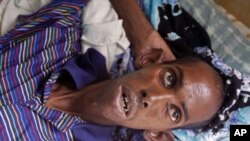SOMALIA / DADAAB UPDATE -- There’s no slowdown in the number of Somalis arriving at the Dadaab refugee camps in northeastern Kenya. The U.N. refugee agency (UNHCR) says thousands more are arriving each week. Drought and famine are forcing many people to walk 15 to 20 days in dry, dusty weather to reach the camps.
“The average daily arrivals for the first week of August was over 1,400 and that brings the new arrivals to that camp so far this year to about 127,000. In July, we had more than we ever had in the 20-year history of the camp. It was over 40,000 people and it looks like we’re well on the way to that again,” said UNHCR spokesman Ron Redmond, who spent most of this week at Dadaab. (To listen to interview click on the player below)
Getting bigger
Initially, Dadaab was constructed to hold about 90,000 people. However, it’s been expanded to accommodate several hundred thousand.
“That was a problem for the last couple of years because the Kenyans did not want us to put more people in that camp. But there are so many coming across that we’ve agreed now that we’ll open two new additions to the camp. One of them is called the Ifo Extension, which is part of the old Ifo camp, but it’s a new area there. We’re going to put 90,000 people in that site,” he said.
The second expansion is called Cambios, a totally new camp. It will be the fourth large refugee camp at Dadaab and will also hold 90,000 refugees.
Redmond said, “If the numbers coming in continue as they have been, we’re probably going to fill both of those in the next four to six months.”
|
Definition of Famine: The word famine is a term that is not used lightly by humanitarian organizations. The United Nations describes a crisis as a famine only when the following conditions are met:
Current Famine:
|
Numbers tell the tale
The large influx of refugees is the biggest sign of drought conditions in Somalia.
“We know that things are exceptionally bad inside Somalia. We’ve got camps besides here in Dadaab. We’ve also got camps in Ethiopia in a place called Dollo Ado and they were earlier getting about 2,000 a month. That’s declined a bit,” he said.
UNHCR staffers have visited the refugee corridors to Kenya and Ethiopia and talked to those seeking food and water.
“They stated if they could they would stay in Somalia if we can get help into them. So that’s going to be the next step, to try to get assistance to people in place so that they don’t have to cross international borders if they don’t want to and can get help there until the rains come and they can go back to their farms,” said the UNHCR spokesman.
Long-term
Many climate and weather experts have forecast continued frequent drought conditions in the Horn of African for years to come. So while emergency efforts are needed to save lives now, long-term policies are also required.
“This has already been a long-range situation, much too long. We’ve been in these camps for 20 years and for most of those 20 years the plight of these Somalis has been largely out of sight. Now that there’s this drought compounding the situation, they’re back on the international radar screen. But it’s been our position all along that first of all there has to be a political solution to this situation in Somalia,” said Redmond.
The UNHCR has called on both the international community and Somalis to find that solution. There has been almost constant conflict in Somalia since the 1990s, following the fall of leader Mohammed Siad Barre. The current Transitional Federal Government and its AU allies have been at war with militias, especially al-Shabab.
“As far as long-term weather patterns and climate change and so on, I mean that’s another major concern on top of this for the Horn of Africa. But, right now, we need peace and stability in Somalia. There are hundreds of thousands of people I think who would go home if they saw a future in that country, but right now they don’t,” he said.
|
At the Dagahaley refugee camp in Dadaab, Kenya, families fleeing the famine in Somalia are given aid, but also face new challenges. VOA's Michael Onyiego visited the camp and took these pictures. |














